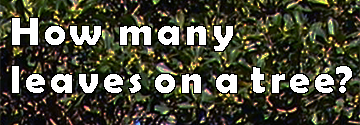



The inherent limitations present in the grammars of all human languages, can lead to distortions in perception and false assumptions about the nature of the world.
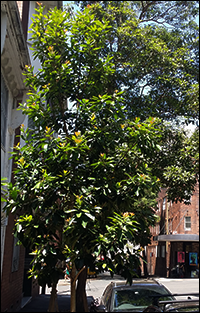
You can form the question: ‘How many leaves on a tree?’ And it seems reasonable that you can count the leaves on a tree and arrive at a definitive number.
The indefinite article ‘a’ is the first point of confusion: what tree are we talking about? Some of them are huge, with small leaves. Some of them are small with large leaves.
Let's take a particular small tree with largish leaves — ‘this tree’ — counting the leaves seems possible.
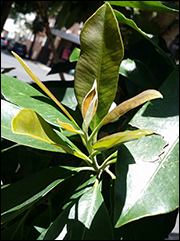
The counting appears to go well, but as we clamber around on a ladder, a couple of leaves fall off onto the ground. We'll take those off the total, so the count goes on.
All goes well with the mature leaves: they are all fully formed and a dark green colour. The growing tips of the branches however, present a problem:
There are a few leaves that are almost fully formed but small and brownish. Then, right at the growing tips there are small structures — would you call them leaves? or are they still just ‘shoots’, which should not be included in the count?
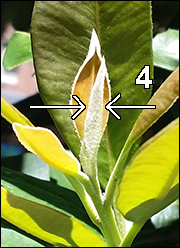
What initially appeared to be an objectively verifiable proposition — ‘How many leaves on a tree?’ — requires a subjective judgement.
I decide that the types of leaves labelled ‘1’, ‘2’ & ‘3’ should be included in our count as leaves, whilst the shoot, labelled ‘4’ is not a leaf but a shoot, and shouldn't be included in the count.
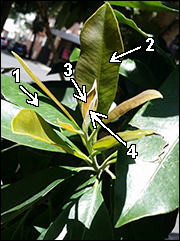
The count continues throughout the morning and I have to start over several times, because I get confused as to which branches I have counted and which not. I settle on a system of tying a length of red wool around each branch when I finish counting its leaves.
I stop for lunch and continue on throughout the afternoon.
I finally arrive at a figure of 3,796. What a relief. As I congratulate myself on my achievement. I lean against the tree trunk and look at the first branch I counted.
In the time I had taken to do my count, the first tip, that I discounted as a non-leaf, has developed, opened, and now must be added to my count as a ‘leaf’. And I ask myself: ‘How many more tips have become leaves?’
What seemed like a verifiable, logical fact, the number of leaves on a tree, has become an exercise in subjective judgement and practical limitations.
We can hold onto the concept of ‘the number of leaves on a tree’ as a workable image for discussion purposes. However, it is just that: ‘imagery’. The simplicity of the question: ‘How many leaves on a tree?’; belies the difficulties involved in arriving at an absolute number value: we might get close, but our figure will always depend on our subjective definition of ‘leaf’ and the practical limitations of our count.
filler text
* * * * *